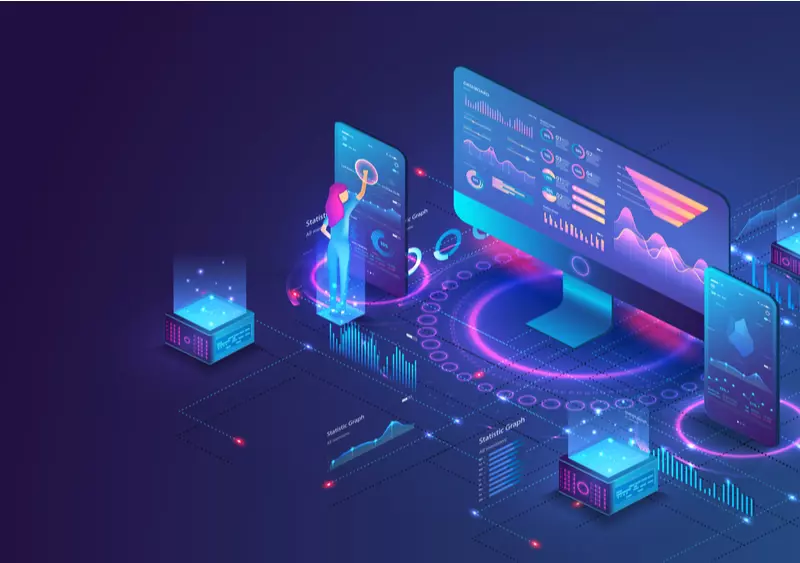What Is Business Intelligence Automation and How to Use It
Business intelligence (BI) uses data mining, business analytics, and other data tools to extract valuable information for organizations to make more informed decisions. However, because of the limitless amount of data available at their disposal, the data extraction process may be cumbersome and time-consuming for many companies.
To derive actionable insights from a large amount of data, many companies have started to utilize business intelligence automation. In this blog, we will explore what BI Automation is, how it is used, and evaluate its risks.
What Is Business Intelligence Automation?

Business intelligence automation refers to the combination of artificial intelligence (AI), robotic process automation (RPA), and business process management (BPM) that reconfigures the data interpolation process for companies. Its main aim is to reduce the involvement of a data analyst or scientist in the process.
BI automation not only accelerates the process but also delivers insights in a more presentable way. As a result, it saves a data analyst’s time on multiple technical tasks. Business intelligence can also process and discover relationships between data from multiple sources and find patterns that data scientists are still unable to uncover.
5 Tasks You Can Automate in Business Intelligence
BI automation unlocks the full potential of data and business analytics. So let’s look at five business processes that can be subject to business intelligence automation.
1. Auto-Discover Insights
As already mentioned, several machine learning tools have made it possible to discover insights automatically. These tools can critically analyze data and find valuable information for companies with very little human involvement.
Lotte, an online shopping company in South Korea, overcame the problem of many customers abandoning their shopping carts through BI automation. As a result, the company saw a sharp increase in customer loyalty and a $10 million increase in sales in one year.
2. Automate the Ranking of Insights
Once you capture applicable insight from data, you have to prioritize them to develop effective business strategies. BI automation goes the extra mile to deliver a ranking of important insights. This classification can save analysts precious time and hint at which improvements to focus on first.
For example, an American Spanish-language television network Univision successfully implemented business intelligence to gain more visibility to its data. Thanks to the power of automation, Univision focused on tailoring targeted ad campaigns to its audience and achieved 80% growth.
3. Embedded Insights
Embedded analytics incorporates data visualization, reports, and charts into a business application or web portal. Reports and dashboards can make meaningful insights easy to access and understand for non-data analysts in a company.
Managers and executives at Baylis & Harding, a wholesaler specializing in first-class toiletries and gift boxes, had problems interpreting customer and sales data. Thanks to embedded analytics, the management now has access to more accessible and comprehensible reports, which helps them plan more forward-looking business decisions.
4. Extract Bias
If data is handled manually, there is always the possibility of human error. Furthermore, even during the extraction of insights, different factors, including flawed observations or unilateral decisions, can create bias in data interpretation. Automation overcomes these obstacles and significantly reduces the chances of committing errors during data analysis.
In 2018, an employee at Strathmore College accidentally published the personal information of more than 300 students on the school’s intranet. The data included information about students’ health conditions, including which medications each student took. Luckily, Strathmore College recovered the data breach the next day. However, implementing BI automation could have easily prevented the unfavorable consequences of an unintentional click.
5. Universal Accessibility
Last but not least, the end goal of business intelligence automation is to provide easy access to business customers. It can allow companies to gather their analytics from any platform that supports BI systems. Moreover, due to the simplified reporting, employees don’t have to be data analytics experts to interpret and apply these insights.
Before implementing business intelligence, New York Shipping Exchange extracted data manually from its website and copy-pasted it into Excel. The process was cumbersome, and not everyone had access to the data. BI helped NYSHEX centralize its data into one single system and make it available to anyone in the company. This major upgrade helped the company gain more visibility into their data, thanks to which they tripled their shipping volume between Asia and the U.S. in 2019.
Risks Associated With Business Intelligence Automation

The only major drawback of BI automation is that it is still new. Because of the lack of widespread application, it is still difficult to evaluate if it can function more powerfully than a human brain. That said, you have to be cautious with the following risks of automation:
- Business Process Failures. Combining different artificial intelligence tools may pose significant challenges for existing technology. It’s still uncertain if all software applications can support BI automation, so it would be best to test it on your machinery before integrating it.
- Loss of Data. Business automation has undoubtedly upgraded the data collection process. However, all these tasks are performed via machines, which still require human intervention to function. Therefore, a simple mishap such as a password reset might result in significant data losses.
- Data Leaks. A single vulnerability might result in data leakage. The growing number of new technologies also brings about more cyber theft and criminality. Without proper information security, a company’s information may easily be subject to a data breach.
Conclusion
Business intelligence and automation go hand in hand to deliver a faster and more accessible data analytics process. It opens many doors for companies to gain more visibility into the data they collect. Thanks to BI automation, the job of a data scientist is slowly shifting from a technical to a more analytical one. However, it’s always advisable to be cautious of the risks associated with automation. Business processes need to be adapted, and new security systems need to be installed to support a more AI-driven approach to data.



